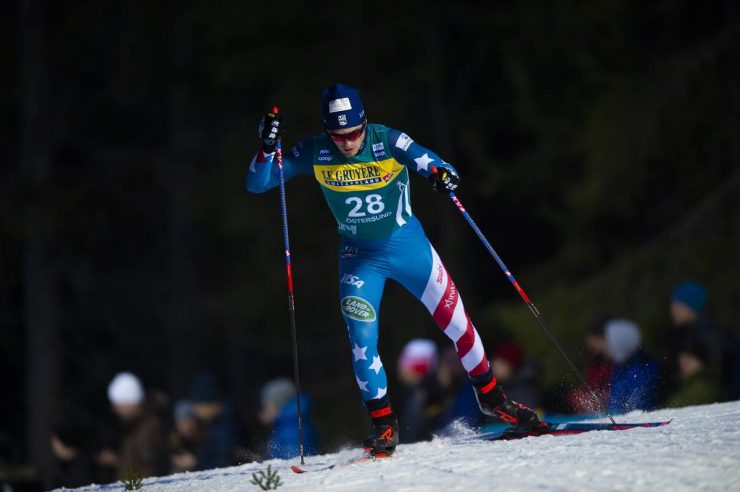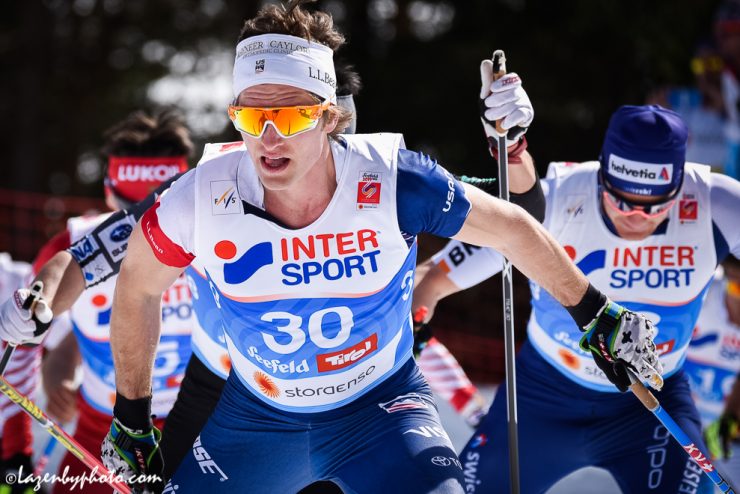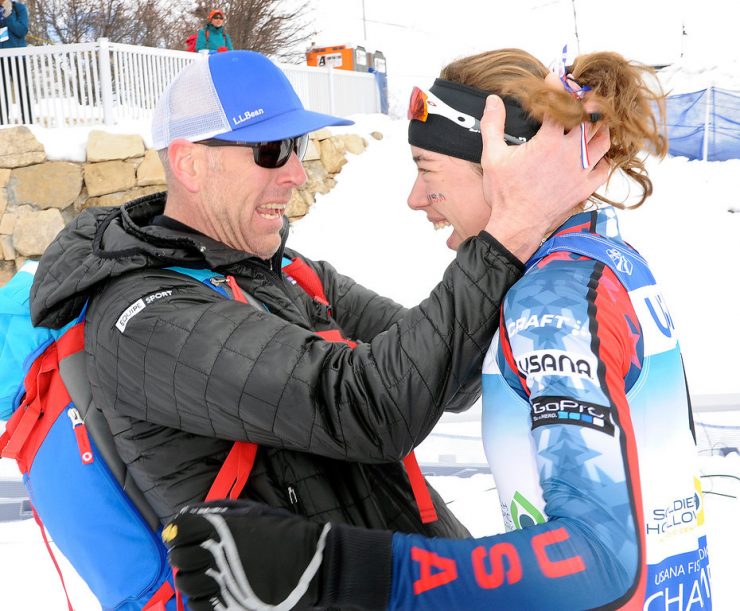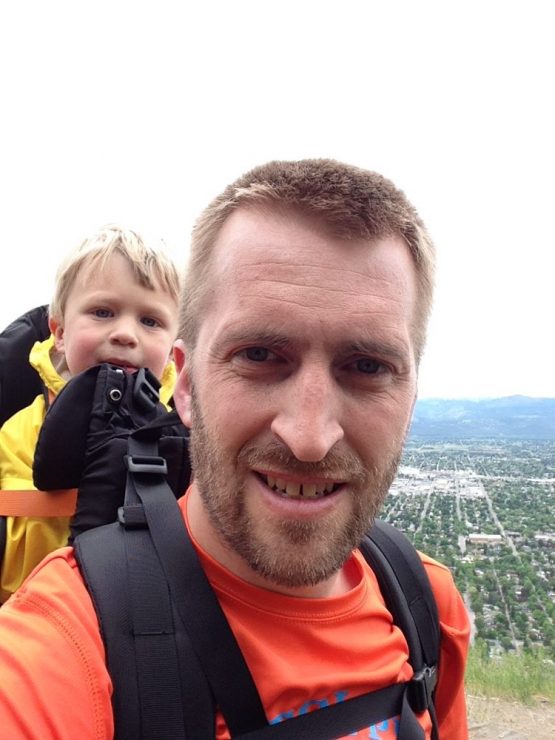
This article has been updated to clarify the relationship between the junior races now known as FIS Nordic Junior World Ski Championships and its precursor, the World Junior Nordic Championships and the European Junior Nordic Championships.
There are, to briefly traffic in the obvious, 60 seconds in a minute. Sixty seconds in a minute; 60 minutes in an hour; 3,600 seconds in an hour. Skiers measure their lives in these increments; we track total yearly training hours, obsess over minutes spent in L3 vs. L4, dutifully record splits from an interval workout down to the second.
David Norris spent roughly 1,000 hours last season in training or racing, or 3,600,000 seconds total. Katharine Ogden may have spent “only” 700 hours, or 2,520,000 seconds, engaged in training or racing. Combined, that’s over six million seconds. This is the story of 12.3 of those seconds, and of their outsize influence on selection to the U.S. national ski team, or USST, fourteen months later.
* * *
Falun, Sweden, March 2019. David Norris, a Fairbanks native who moved to Anchorage after college graduation to ski for Alaska Pacific University, was on a roll. He had had strong results in two recent 50-kilometer races, skiing to 20th at World Championships in Seefeld and 24th at the iconic Holmenkollen within a week. As the World Cup tour moved on to Sweden, Norris looked to continue his torrid streak in the 15-kilometer interval-start freestyle race held on March 17.

Interval start races on the World Cup are generally reverse seeded, with the fastest skiers starting last. In Falun, Norris had bib no. 16 in a field of 69, reflecting relatively high seeding and low expectations – this is not where you put a predicted top-30 finisher. (Indeed, the two athletes immediately ahead of him, bibs 14 and 15, finished well outside the points in 37th and 47th.) Norweigan broadcaster NRK didn’t even show his start, instead cutting away to show a pre-recorded broadcast with Martin Sundby over the span of a half-dozen early starters, including Norris.
But once the race started, Norris showed he belonged. Through three laps of the 5-kilometer course at Falun, he hovered between 11th and 16th. He beat Klæbo. He beat Spitsov. He beat Manificat. When he crossed the finish line, with the sharp end of the field still on course, he was briefly on the virtual podium in second overall. Once all starters had crossed the line he would end the day with a final result of 16th, a notable result for American men’s distance skiing at any point in the past three decades.
Afterwards, Norris told this website, “I am super happy with my result – I feel like I have recovered well from back-to-back 50ks, and my skis were good. Today was the type of result I have been believing I should be able to do on a good day, so I am psyched to have made that happen.” Jason Albert’s contemporary race story for FasterSkier observed, “During a year when the U.S. Ski Team has offered numerous international starts to a host of non-USST members, Norris and his trifecta of results in the points promotes the notion that on the right day and even the right World Cup string of races, elite U.S. skiers can step up.”
Norris’s time for 15 kilometers was 34:33.9. His life would be different now if he had finished in 34:22.9, 11 seconds faster.
* * *
Ten days before Norris’s fateful ski, Katharine Ogden toed the line for the women’s 5 k skate race at 2019 NCAA Championships. She was racing at the Trapp Family Lodge in Stowe, Vermont, two hours from where she grew up in Landgrove and just down the road from where she had attended school at Stratton Mountain. Ogden had to be considered among the pre-race favorites – in seven individual NCAA races so far that season she had seven podiums, including three victories and three second places – and her seeding reflected it. She had bib no. 36 in a field of 40; that is, she was seeded as the fifth-best racer in the field.
A 5-kilometer ski race will take a skilled athlete well under 15 minutes, even on a homologated course. Depending upon the course profile and how much chance for recovery there is, the race can be roughly akin to the world’s longest, most difficult L4 interval. An athlete has to go nearly as fast as sprint pace, for roughly four times as long, without completely blowing up and losing valuable seconds against a tight field.
On this day, and even over “just” five kilometers, Ogden metered out her effort better than nearly anyone else in the field. At the two-kilometer mark, she was in ninth. By the halfway mark, she was down to 11th, not only off the podium but also out of All-America status. But she came on strong over the final 2.5 kilometers, moving up seven places in as many minutes. Coming down the finishing straight she drew even with her Dartmouth teammate Lydia Blanchet, who had started 30 seconds before her in bib no. 35, then moved alongside to out-lunge Blanchet at the finish.
Ogden finished just off the podium in fourth, even after, according to one contemporary observer, falling at one point on the course. Her time for 5 kilometers was 13:34.5. Fourteen months later, she would miss objective selection to the 2020/2021 USST B-Team by a fraction of a FIS point. If she had gone just 1.3 seconds faster in this race, 13:33.2 instead of 13:34.5, she would have made the team.
* * *
A year later, Ogden made the team anyway, following the application of discretionary selection by U.S. Ski Team leadership. At the end of this season, she had 49.45 points on the final women’s FIS Distance List, good for 81st in the world. The athlete one spot ahead of her in 80th had 0.25 fewer points, or 49.20. A female athlete born in 1997, like Ogden, needed a year-end distance ranking of 80th or better to merit selection to the USST B-Team via objective criteria. Ogden was very close, but 81st is not 80th.
Norris, meanwhile, ended up with 22.95 points on the same final men’s FIS Distance List released this March, good for 43rd in the world. (22.95 points would have left him ranked 18th on the women’s list; as previously discussed, the men’s field is tighter than the women’s at every level of the distance rankings.) The athlete three spots ahead of him in 40th had 0.88 fewer points, or 22.07. A male athlete born in 1991 or earlier, like Norris, needed a year-end distance ranking of 40th or better to merit selection to the USST B-Team via objective criteria. He was very close, but 43rd is not 40th.
* * *
The criteria for objective selection to the national team, which this year key on an athlete’s FIS points-based world ranking and are adjusted for age and (in some cases) gender, are of recent vintage.
In announcing the new criteria at the start of the 2019/2020 season, then-USST Head Coach Chris Grover wrote, “these criteria create many objective pathways to a USST nomination and identify a clear path for athletes, coaches, and parents to understand exactly what is necessary to be nominated to the USST. … I’m confident that these new criteria will help us do a better job of identifying those athletes with the potential to medal while creating better transparency around the U.S. Ski Team nomination process.”

The potential use of discretionary selection alongside objective criteria for selection remains substantively unchanged from previous years. Grover highlighted the use of discretionary selection in an email to FasterSkier earlier this month when asked about the reasoning behind adding Ogden to the team via discretion.
(FasterSkier’s late-April podcast with Matt Whitcomb, which explored Norris’s situation at some length, took place before the official team announcement had been made by U.S. Ski & Snowboard in early May. FasterSkier knew at the time that Norris was not on the team, due to this Instagram post from APU, but did not know that Ogden was on the team, and so did not ask about her selection when it spoke with Whitcomb.)
Grover wrote to FasterSkier, in full (the original email highlighted the penultimate bullet point under discretionary criteria, as has been done here):
Attached is the criterion and below is the specific part of the criterion’s discretionary selection policy we utilized when nominating Katharine to the USST:
Discretionary Selection Policy:
U.S. Ski and Snowboard may select additional athletes to the team, or may select athletes to the B-team who have met D-team criteria, using coaches’ discretion based upon factors other than the objective criteria. If the coaching staff fills any spot(s) on the team with discretionary selections, then the staff may consider any factors including (but not limited to) the following:
- Completion of individual markers, as set forth by the U.S. Ski Team coaching staff and as approved by the U.S. Ski and Snowboard Head Cross Country Coach, which point toward the achievement of competition results consistent with U.S. Ski Team program goals.
- Attitude and commitment of athletes to take part in the complete camp and competition program.
- Illness or injury during the selection period.
- Indicia of medal potential in future Olympic and World Championship competitions, which would be materially enhanced by selection to team.
- Other unanticipated failure of objective criteria to select an athlete likely to achieve competition results consistent with the U.S. Ski and Snowboard program goals.
As you know, Katharine is one of three athletes in USA World Junior history to achieve an individual medal, so she clearly meets the above criteria.
The reference is to Ogden’s bronze medal in the women’s 10-kilometer skiathlon at 2017 World Juniors in Soldier Hollow. The other American athletes with individual World Juniors medals are Hailey Swirbul, in 2018, and Gus Schumacher, in 2020. That said, American skier Bill Koch won an individual medal in the 1970s version of what are now colloquially known as “World Juniors” at the 1974 European Junior Nordic Championships.†
Whitcomb also spoke to the relationship between junior medals and senior success in the recent podcast. Whitcomb observed, “There’s a big difference between being a top-10 skier or a medalist at World Juniors and converting that to top tens and medals on the World Cup. And it’s not a gimme.” He suggested, however, that this is “the benchmark that seems to be required to have World Cup success or Olympic or World Championship success,” based on internal national-team data going back over the past 10 or 15 years.

He added, “With that you have exceptions like Holly Brooks who never went to World Juniors and is a World Cup … podium skier. So you’re not out of luck if you didn’t get into the top 10 or top 12 or on the podium at World Juniors.”
Americans who have previously medaled at Olympic or World Championship competitions without achieving an individual medal at World Juniors include Kikkan Randall, Jessie Diggins, Caitlin Gregg, and Sadie Maubet Bjornsen. Bill Koch is the only American skier who has achieved both an individual juniors global championships medal and an Olympic or World Championship medal.†
Gregg is the only American who has medaled at a global championship while not a member of the U.S. Ski Team.
Athletes with no individual World Juniors medal currently on the U.S. Ski Team include Maubet Bjornsen, Rosie Brennan, Sophie Caldwell, Diggins, Julia Kern, Simi Hamilton, Kevin Bolger, Scott Patterson, Logan Hanneman, Hannah Halvorsen, Novie McCabe, Kendall Kramer, Sydney Palmer-Leger, Sophia Laukli, Johnny Hagenbuch, Luke Jager, Noel Keeffe, Ben Ogden, JC Schoonmaker, and Hunter Wonders.
* * *
David Norris, like the 20 athletes listed above, also has no individual medal from World Juniors. He finished 29th and 43rd at the 2010 World Junior Ski Championships in Hinterzarten, Germany, where he also skied on a relay team with Sam Tarling, Scott Patterson, and Erik Bjornsen. These races were some time ago; Norris is now 29. (He was born in December 1990. Had he been born thirteen months later, in 1992, he would have made this year’s team.)
One recent chart from Joran Elias at Statistical Skier appeared to show that roughly 75% of male skiers who achieve a top-10 result in a high-level distance race do so by the age of roughly 26 (closer to age 28 for women). Another series of charts appears to show that both Norris and Ogden fall within the upper end of the historical age-based performance range for achieving “top international results,” defined by Elias as at least three top-10 finishes in high-level distance races. (Larger versions of the charts are available on Twitter here.)

The USST’s decision not to add Norris to the national team via the exercise of discretion was discussed at length in the final segment of FasterSkier’s recent podcast conversation with Whitcomb. Briefly put, Whitcomb pointed to the criteria’s emphasis on global championships medal potential, and argued that Norris is not currently on track to achieve such results:
“We have to be able to argue that David is on track to be a medalist at World Champs or at the Olympics. And we can’t argue that. We can argue that he is on track to continue to improve, he’s on track to get into the top-15 next year – but that, at [age] 29 or 30, doesn’t merit a B- or an A-Team spot, which now involves $25,000 of funding, roughly, if you are running the World Cup full season, and all the camps. As much as I want him there and on those teams, we can’t argue it. And so – David’s an incredible role model, as the fastest distance skier that we had this last season, and hopefully he’s our fastest distance skier this next year and continues to improve.”
Whitcomb added, “And so what’s the message for juniors that are disheartened by that? I think the message is that it’s not easy to make the B-Team. It’s going to take exceptional commitment from a pretty young age.”
At least one junior was disheartened by this message. “It’s really sad and makes me question the integrity of the selection process,” a top American junior skier told FasterSkier of Norris being left off the team. (The athlete was granted anonymity to discuss a sensitive matter.)
Whitcomb added, in reference to the season just concluded where Norris raced on the World Cup all year, “David was a pleasure to have on the World Cup all season. And once an athlete’s on the World Cup, you’re basically on the national team. This is not the U.S. Ski Team once we hit the road, it’s U.S. skiing. And I think David would agree that we’ve, as a nation, gotten better at being inclusive of people inside and outside of the team.”
Other athletes who have made periodic World Cup starts in Europe may not agree. (Multiple athletes who were approached for this story declined to officially comment, even anonymously.) For those commenting on background, a common theme in these athletes’ experience is reduced access to quality skis or wax tech support for non-national-team athletes (even after paying for a wax tech out of pocket), which is no small thing when racing at a level where ski preparation can make such a large difference. These same athletes, again speaking on background, have generally suggested that ski team leadership acted more in response to logistical constraints than in an outright bad faith attempt to hinder their performance.

As a specific example, some ski manufacturers’ contracts specify that an athlete cannot receive a certain level of support without being a member of the national team, so racing in Europe independently, even alongside USST members and otherwise being included as a part of the team in a general sense, can compromise an athlete’s access to support for skis and service. Some athletes also talk about a more general, unwelcoming sensation of feeling like an outsider, even when traveling and racing immediately alongside named members of the national team.
Said one American skier who has raced European World Cups not as a member of the national team, “When you show up to a World Cup as a domestic athlete, you are a guest. Although not marketed as so, it shouldn’t be a surprise. You’re given the uniform, housed with the team, hopefully assigned a wax tech (but best to bring your own), and they have your credit card for billing. As a ‘bubble athlete,’ the pressure is immensely high, and you have a brief opportunity to prove you belong there. When you’re on the World Cup as a part of the team, there is also a lot of stress to perform, however you’re allowed a season to experience mistakes, try tactics, and build your confidence in that scene. History has shown that the USST favors granting discretion to younger athletes, leaving older athletes to fight for spots as outsiders.”
The athlete quoted immediately above competed on the World Cup in a season when Grover was the head coach and Whitcomb was the women’s team coach. Whitcomb now holds the position of head coach, effective as of last month.
Whitcomb said, in reference to the advantages of being an official member of the team, “Opportunities and doors are not closed. But the bummer is that the funding was missed; that’s one of the big things. Plus just being a part of the team; it instills confidence when you know the people that you’re on the road with are your teammates. But we try and do our best to have those that aren’t actually on the team to feel like they’re a part of it as well, and that will be a goal of mine.”
* * *
11 seconds out of 3,600,000. 1.3 seconds out of 2,520,000. Fractions of fractions of a percent – that’s 0.00031 percent of Norris’s total training year, and 0.000052 percent of Ogden’s. For two athletes seeking to fund European racing and wondering what the next race season holds for them, that fraction of a FIS point – even assuming no value to team status or team dynamics or better ski support or increased sponsorship opportunities or improved access to World Cup starts – was worth at least $25,000. Every second counts, indeed.
***
A note on methodology, and an attempt to show my work:
An athlete’s sprint or (in this case) distance points are typically determined by taking the average of his or her five best points results in that discipline over the past 12 months. The 2019/2020 year-end FIS Points lists actually go back farther than that, to early March 2019, presumably because of the large number of FIS races cancelled from early March 2020 onwards. (Elias, at Statistical Skier, logged roughly 1,000 unique ski races in each of the 2017/2018 and 2018/2019 seasons, but only 681 ski races for the 2019/2020 season.)
Among races held in that time, Ogden’s five best results are from March 6, 2019 (53.97 points); March 8, 2019 (49.28 points); Dec. 7, 2019 (44.25 points); Dec. 15, 2019 (54.10 points); and Jan. 26, 2020 (45.63 points). This is a total of 247.23 points, or an average of 49.446, which is rounded to 49.45 in the world rankings list. Ogden won the races held on March 8, December 7, and January 26, so, short of finding more fast people to enter and beat, there is nothing she could have done to improve her points in those races. That leaves the races of March 6 and December 15. Of those two, the December race was a mass-start race held over 10 k, with a winning time of roughly 27 minutes; the March race was an interval-start 5 k, with a winning time of roughly 13 1/2 minutes. I chose the shorter, interval-start race to illuminate the narrowness of the margin keeping Ogden from the team; you could re-run the math using the mass-start race instead, and come up with a slightly larger margin. (Also relevant, and acknowledging the need to tell a story rather than just set forth some math problems, I could find more information about the March race, because it was an NCAA race and Dartmouth Skiing wrote about it on its website in some detail.)
For Norris, meanwhile, his five best results are from March 3, 2019 (17.52 points); March 9 (20.54 points); March 17 (30.14 points); March 30 (24.87 points); and April 2 (21.66 points). This is a total of 114.73 points, or an average of 22.946, which is rounded to 22.95 in the world rankings list. Norris won none of these races, so in theory you could re-run the math for him on the assumption that he did just slightly better in all five of them, instead of 11 seconds better in one of them. I chose the March 17 interval-start race because it was the highest single value of those five results, and made it clear how performance in a single race most directly impacts the final FIS points number. As with Ogden, I similarly chose a shorter, interval-start race to highlight the narrowness of the margin keeping Norris from the team; you could re-run the math with some or all of the mass-start races, and come up with a slightly larger margin for one race, or, smaller margins for multiple races.
***
† Chris Grover’s emailed statement, that only three American skiers have won an individual medal in “USA World Junior history,” is literally true, but only because the races now generally known as “World Juniors,” which currently have the official name of “FIS Nordic Junior World Ski Championships,” have only been consistently known as “World Juniors” since 1977. A global championship for junior cross-country athletes began in 1968, and was held annually. As Nordic Canada magazine noted in the late 1970s (PDF page 4), this race series began as “The World Junior Nordic Championships (as they are called in odd years, or the European Junior Nordic Championships in even years).”
Koch won a bronze medal in an individual race at the 1974 European Junior Nordic Championships, then broadly known as “EJCs,” according to contemporary athletes. The two sentences in the body of this article marked with a dagger (†) have been added to this article since it was initially published to reflect the fact that Koch won a junior global championships medal in addition to medals at the Olympics and the “normal” FIS Nordic World Ski Championships. Had Koch won this medal in either of the odd years of 1973 or 1975, it appears that he would have instead medaled at “World Junior Nordic Championships.”
Gavin Kentch
Gavin Kentch wrote for FasterSkier from 2016–2022. He has a cat named Marit.



